Small overlap front
The small overlap front evaluation consists of a driver-side and a passenger-side component. If the results of the two evaluations differ, then the combined small overlap rating is equal to the lower rating.
Driver-side
- Rating applies to 2022-25 models
Tested vehicle: 2022 Jeep Grand Cherokee L Laredo 4-door 4wd
The Jeep Grand Cherokee L, a 3-row version of the Grand Cherokee, was introduced in the 2021 model year and the 2-row Jeep Grand Cherokee was redesigned for the 2022 model year.
| Evaluation criteria | Rating |
|---|---|
| Overall driver-side evaluation | |
| Structure and safety cage | |
| Driver injury measures | |
| Head/neck | |
| Chest | |
| Hip/thigh | |
| Lower leg/foot | |
| Driver restraints and dummy kinematics | |

Action shot taken during the driver-side small overlap frontal crash test.

The dummy's position in relation to the door frame, steering wheel, and instrument panel after the crash test indicates that the driver's survival space was maintained very well.
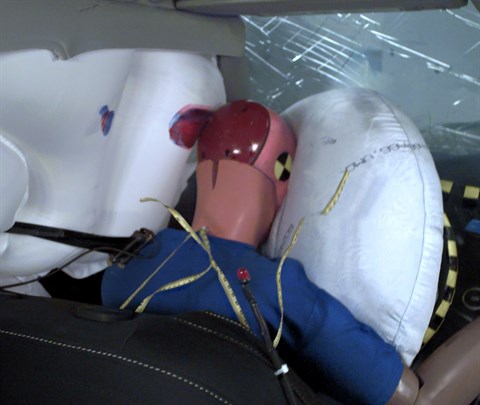
The frontal and side curtain airbags worked well together to keep the head from coming close to any stiff structure or outside objects that could cause injury.
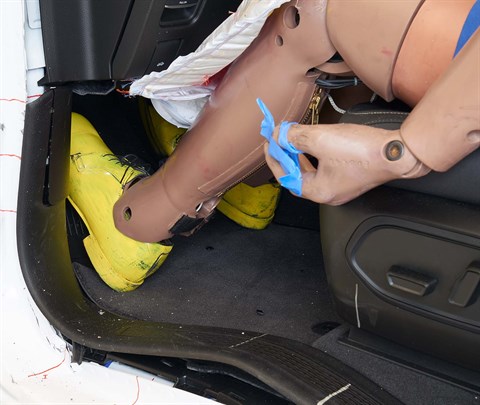
The driver's space was maintained well, and risk of injuries to the dummy's legs and feet was low.
Passenger-side
- Rating applies to 2022-25 models
Tested vehicle: 2022 Jeep Grand Cherokee L Limited 4-door 4wd
The Jeep Grand Cherokee L, a 3-row version of the Grand Cherokee, was introduced in the 2021 model year and the 2-row Jeep Grand Cherokee was redesigned for the 2022 model year. Beginning with 2022 models, modifications were made to the front passenger-side carpet pad to improve occupant safety in passenger-side small overlap crashes. Passenger-side small overlap frontal ratings are assigned by the Institute based on a test of a 2022 Jeep Grand Cherokee L conducted by Stellantis.
| Evaluation criteria | Rating |
|---|---|
| Overall passenger-side evaluation | |
| Structure and safety cage | |
| Passenger injury measures | |
| Head/neck | |
| Chest | |
| Hip/thigh | |
| Lower leg/foot | |
| Passenger restraints and dummy kinematics | |
| Driver injury measures | |
| Head/neck | |
| Chest | |
| Hip/thigh | |
| Lower leg/foot | |
| Driver restraints and dummy kinematics | |
Moderate overlap front: original test
Rating applies to 2022-25 models
Tested vehicle: 2021 Jeep Grand Cherokee L Limited 4-door 4wd
The Jeep Grand Cherokee L, a 3-row version of the Grand Cherokee, was introduced in the 2021 model year and the 2-row Jeep Grand Cherokee was redesigned for the 2022 model year. Moderate overlap frontal ratings are assigned by the Institute based on a test of a 2021 Grand Cherokee L conducted by Stellantis.
| Evaluation criteria | Rating |
|---|---|
| Overall evaluation | |
| Structure and safety cage | |
| Driver injury measures | |
| Head/neck | |
| Chest | |
| Leg/foot, left | |
| Leg/foot, right | |
| Driver restraints and dummy kinematics | |
Moderate overlap front: updated test
Rating applies to 2022-25 models
Tested vehicle: 2022 Jeep Grand Cherokee Trailhawk 4-door 4wd
The Jeep Grand Cherokee (2-row) was redesigned for the 2022 model year. These ratings do not apply to the 3-row version of the Jeep Grand Cherokee.
| Evaluation criteria | Rating |
|---|---|
| Overall evaluation | |
| Structure and safety cage | |
| Driver injury measures | |
| Head/neck | |
| Chest | |
| Thigh/hip | |
| Leg/foot | |
| Driver restraints and dummy kinematics | |
| Rear passenger injury measures | |
| Head/neck | |
| Chest | |
| Thigh | |
|
Rear passenger restraints and dummy kinematics
| |
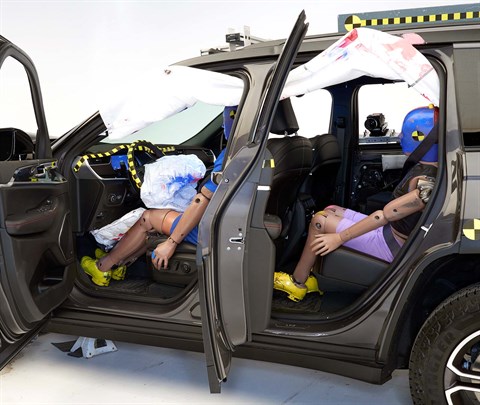
View of the vehicle after the crash showing the airbags and damage to the occupant compartment.
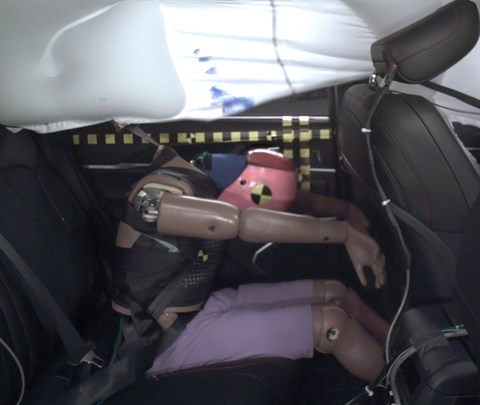
The rear passenger dummy's head approached the front seatback, which increases the risk of head injuries.
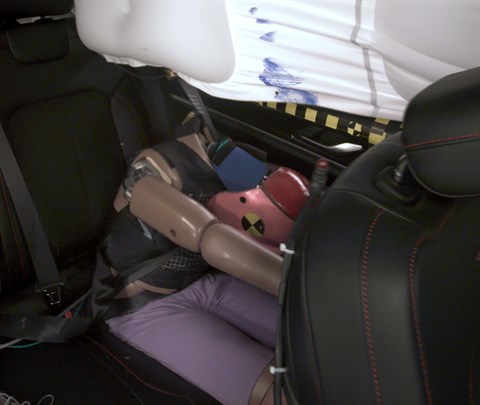
Rear passenger dummy injury values indicate a likely risk of injury to the head or neck and chest. During the crash, the shoulder belt remained in an ideal position on the dummy’s chest.
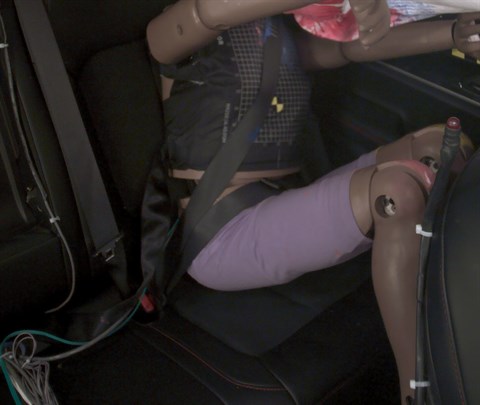
The rear passenger dummy's lap belt remained in the ideal position on the pelvis.
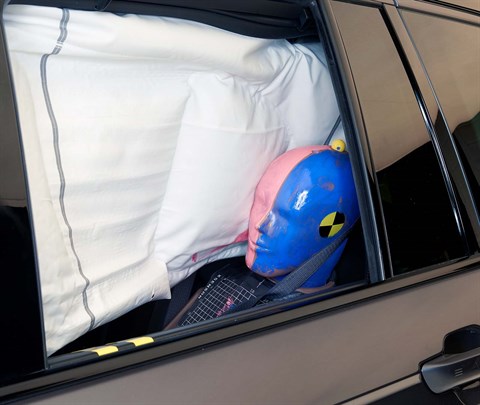
During rebound the rear passenger dummy's head moved outside of the side curtain airbag. The head protection is inadequate and puts the head at risk of possible contact with outside objects.
Side: updated test
Rating applies to 2023-25 models built after March 2023
Tested vehicle: 2023 Jeep Grand Cherokee Laredo 4-door 4wd
The Jeep Grand Cherokee (2-row) was redesigned for the 2022 model year. Beginning with 2023 models built after March 2023, structural modifications were made to the underbody to prevent fuel leaks in side impact crashes. (Information about when a specific vehicle was manufactured is on the certification label typically affixed to the car on the driver door or adjacent B-pillar.)
| Evaluation criteria | Rating |
|---|---|
| Overall evaluation | |
| Structure and safety cage | |
| Driver injury measures | |
| Head/neck | |
| Torso | |
| Pelvis | |
| Driver head protection | |
| Rear passenger injury measures | |
| Head/neck | |
| Torso | |
| Pelvis | |
| Rear passenger head protection | |
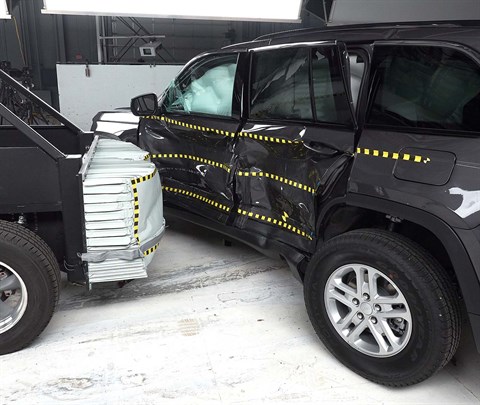
View of the vehicle just after the crash test.
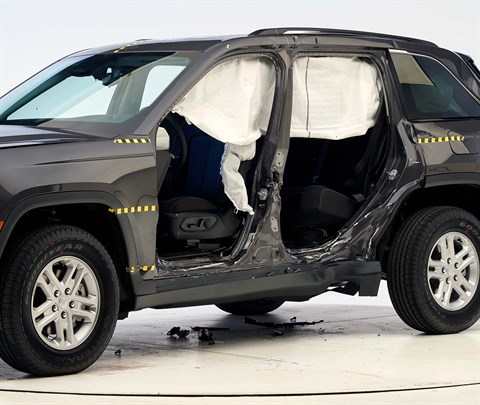
View of the vehicle after the crash with doors removed, showing the side airbags and damage to the occupant compartment.
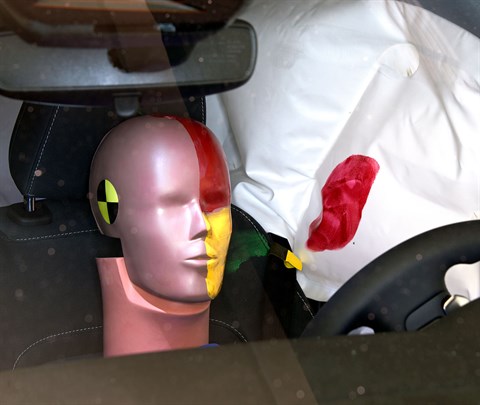
Smeared greasepaint shows where the driver dummy's head was protected from being hit by hard structures by the side airbags.
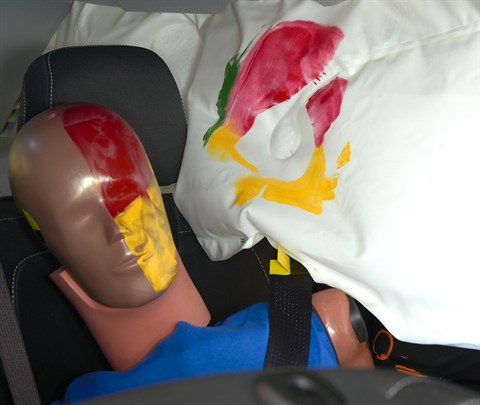
Smeared greasepaint shows where the rear passenger dummy’s head was protected by the side airbag.
Headlights
Ratings are given for 2 different headlight variations available on this vehicle.
Trim level(s)
- Limited trim
- Overland trim
- Summit trim
| Evaluation criteria | Rating |
|---|---|
| Low-beam headlight type | LED reflector |
| High-beam headlight type | LED reflector |
| Curve-adaptive? | No |
| High-beam assist? | Yes |
|
Overall rating | |
| Distance at which headlights provide at least 5 lux illumination: | |
Low beams
On the straightaway, visibility was good on both sides of the road. On curves, visibility was good on both right curves, fair on the sharp left curve and inadequate on the gradual left curve.
The low beams never exceeded glare limits.
High beams
On the straightaway, visibility was good on the right side of the road and fair on the left side. On curves, visibility was good on the gradual right curve and fair on the sharp right and both left curves.
High-beam assist compensates for some limitations of this vehicle's low beams on the straightaway, on both left curves and on the sharp right curve.
Trim level(s)
- Laredo trim
| Evaluation criteria | Rating |
|---|---|
| Low-beam headlight type | LED reflector |
| High-beam headlight type | LED reflector |
| Curve-adaptive? | No |
| High-beam assist? | No |
|
Overall rating | |
| Distance at which headlights provide at least 5 lux illumination: | |
Low beams
On the straightaway, visibility was good on both sides of the road. On curves, visibility was good on both right curves, fair on the sharp left curve and inadequate on the gradual left curve.
The low beams never exceeded glare limits.
High beams
On the straightaway, visibility was good on the right side of the road and fair on the left side. On curves, visibility was good on the gradual right curve and fair on the sharp right and both left curves.
Front crash prevention: pedestrian
Ratings are given for 2 different systems available on this vehicle.
Seat belt reminders
Rating applies to 2022-25 models
| Evaluation criteria | Rating |
|---|---|
| Overall evaluation | |
| Front row | |
| Unbelted occupant alert (audible & visual) | |
| Initiation time | |
| Duration | Long enough (90+ seconds) |
| Volume | |
| Audio frequency | |
| Second row | |
| Startup status alert (visual) | None |
